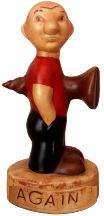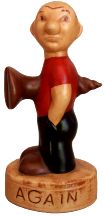 |
 The Virtual Corkscrew Museum's Weekly Newspaper |
 |
 |
 The Virtual Corkscrew Museum's Weekly Newspaper |
 |
|
February 25, 2007 |
Buying Tips
Don't be a victim of auction fraud. We emailed a list of our proposed "Buying Tips" to corkscrew collectors. A number of collectors reported being bitten by unscrupulous sellers. The numerous responses contained many interesting red flags and tips resulting in a bit longer list which is well worth a serious study. Before bidding, here are some things to consider:
Use caution when bidding on listings that use or overuse the words rare, vintage, unique, or "from an estate". Some may be legitimate but be careful.
Josef L'Africain looked at the current corkscrew listings on Tuesday, February 20, 2007 at 5:43 PM. His analysis: "Of the current 991 listings for corkscrews under the “collectibles/barware/corkscrews” section (in either their title, or description) 118 are rare, 287 are vintage, 25 are “from an estate”, and 64 are unique... 28 are rare and vintage, 16 are rare and unique, 7 are rare and from an estate, 25 are unique and vintage, 15 are unique and from an estate, and 6 are rare, from an estate, and unique—oddly enough, all 6 are from the same seller."
If the listing is a private auction, watch out.
If payment is requested by telegraphic transfer or cash, be wary.
Check the seller's feedback and then check the feedback of those who left feedback. Are there a lot of matches? Perhaps they are pumping up each other's feedback or the seller is using more than one screen name. Tread lightly.
Beware of sellers who hide their feedback.
Does the seller say something like "I'm not an expert on corkscrews, so you be the judge"? Be cautious.
If the seller doesn't answer a question in a reasonable length of time before the end of the auction, doesn't answer at all, or says they can't answer because they just listed the item for a friend, stay away. If you do get a reply but the answer is not direct and clear, still stay away.
Poor photo? Request another. Request several.
Copy the picture to your desktop and use your photo software to enhance it to look for details.
Are the photos out of focus? Beware of those who use the excuse that they have a poor camera or do not know how to use their camera to get good shots.
Very often the worm is an indicator of a fake, either being of an inferior quality or just different to all the known worms for the particular corkscrew.
Keep in mind that old rust is not orange.
Check your reference books for pictures and descriptions of the corkscrew. That at least will help identify cheap reproductions.
Understand the difference between fake and reproduction.
Know currently produced corkscrews.
If it looks too good to be true, it probably isn't.
Buy from sellers you trust and know.
Think long and hard about bidding on items with descriptions including things like "it appears to be …”, “just like one which sold (for a fortune) recently”, “in good condition for its age”, “the damage would be easy to repair”, “I do not know if it is genuine”, "been in the family for years", or some long winded story where the all the facts don't match the age of the corkscrew.
If you do bid and you are the underbidder, be very careful of emails received after the auction offering you the same or similar item. Again, know the seller.
If collectors will stop bidding on the corkscrews that are fakes, reproductions, or frauds, the sellers may eventually go away!
Note: The Weekly Screw will not publish seller names, seller IDs, or the item number of the "corkscrew" offered.
|
©2007 Don Bull, Editor |